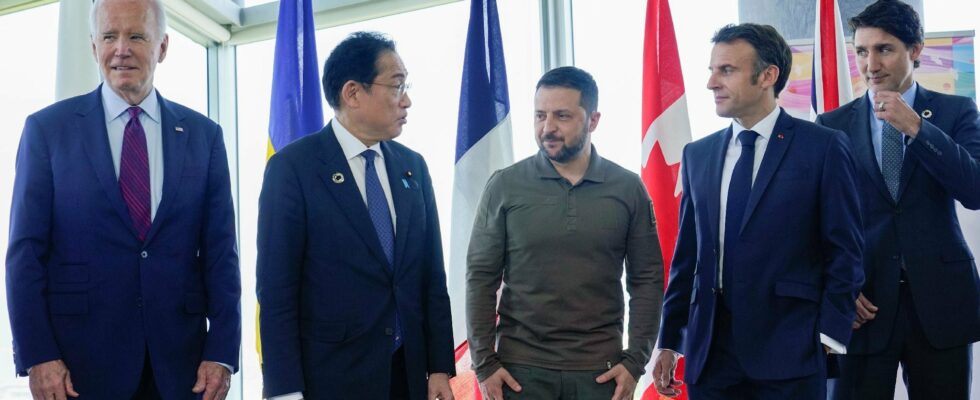What to do with such loot? The G7 leaders are meeting, starting Thursday, June 13, in Italy where they will try to agree on a mechanism allowing the use of frozen Russian assets to help Ukraine defend itself.
Under Italian presidency, the “Group of 7” (United States, Germany, France, Italy, United Kingdom, Canada, Japan) meets in the luxurious seaside resort of Borgo Egnazia, in Puglia (south). Faced with the specter of a return to the White House of Donald Trump and the uncertainty surrounding the consequences of his election for Ukraine, the G7 wants to secure the financing of its military aid to kyiv.
What do these Russian assets represent?
The European Union and G7 countries have frozen some 300 billion euros in assets of the Central Bank of Russia, according to the EU. They also seized private assets of people linked to Russian power. According to the Institute of Legislative Ideas, a Ukrainian think tank which claims to question official sources, $397 billion is tied up.
Note that this sum is made up of European sovereign bonds held by the Russian Central Bank – that is to say debt. And part of the jackpot – 190 billion – is sitting in the private clearing house Euroclear, based in Belgium. It is she who pays the money to central banks around the world. As it no longer gives the Russians anything, the frozen assets produce interest. This gives preponderant weight to Europe over the use of Russian assets. The rest is mainly shared between the United States, Japan, the United Kingdom, Austria and Switzerland.
What are the G7 issues around these assets?
The G7 hopes to reach consensus on the use of Russian assets frozen by the West to provide Ukraine with budgetary support and help it rebuild the country. If the support of allies and the loan from the IMF allow kyiv to stay afloat, other solutions will soon have to be put on the table to ensure the proper functioning of public services. For its part, the World Bank estimates the cost of rebuilding Ukraine at more than $486 billion.
The countries of the European Union adopted an agreement at the beginning of May 2024 to seize the financial interests generated by Russia’s assets frozen in order to arm Ukraine, a windfall representing between 2.5 and 3 billion euros per year . A first payment to Ukraine should thus be made in July, 90% of which will be intended for the acquisition of military equipment. This contribution, however, remains insufficient in view of kyiv’s needs. The objective of the Twenty-Seven is to support the recovery, reconstruction and modernization of Ukraine, in particular to finance “essential reforms on the path to its accession to the EU”.
In the process, the big financiers of the G7 meeting in Stresa at the end of May agreed on the principle of using the future interests of Russian assets. According to Paris, an agreement in principle has already been sealed “on the disbursement of 50 billion” dollars “before the end of 2024”. For their part, the United States seemed more cautious. The G7 intends to announce a “framework”, as well as a timetable, the details of which will have to be finalized later, according to Jake Sullivan, Joe Biden’s national security adviser. Other States, behind the scenes, are asking for guarantees.
Furthermore, the United States is putting pressure on the G7 countries to agree to a mega-loan of around $50 billion guaranteed by future interest generated by immobilized Russian assets. But several European countries remain reluctant to this idea which raises several questions. In particular whether such a sum could encourage Washington to ease up on financial aid.
Is the confiscation of this money possible?
Washington would lean towards a more radical solution: confiscating Russian assets frozen in Europe and transmitting them to Ukraine. In other words, the United States wants to seize capital rather than interest. Except that Europeans remain cautious. Such confiscation would be a rupture in the international order, at a time when Europe would like Russia to respect it, said Christine Lagarde, the president of the European Central Bank.
In addition to fearing a loss of confidence from third countries, Westerners face “immunity from execution”, a legal principle which prevents the seizure of the property of one State by another.
And what would happen if the assets were released in the event of a peace agreement?
G7 finance ministers reaffirmed that Moscow’s assets “will remain tied up until Russia pays for the damage it has caused to Ukraine.” Hence the prospect that Russian assets can generate profits for a long time to come. Some also worry about an impact on investments from third countries, such as China, which could reduce their assets in Western countries for fear of them being seized.
Russia has also threatened retaliation against Western private interests. Vladimir Putin thus signed a decree at the end of May authorizing the confiscation in the Federation of assets belonging to the United States or to people “associated” with it.
